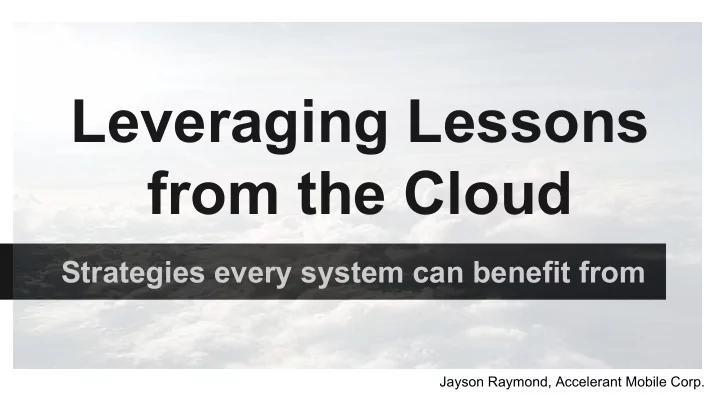

Leveraging Lessons from the Cloud Strategies every system can benefit from Jayson Raymond, Accelerant Mobile Corp.
Motivation for the Cloud Need a massive internet presence that doesn’t cost you monthly? Amazon turned a cost center to a $6B/yr profit center
Key Principles Economies of Scale Applying Principles of RAID to the Data Center ● “Redundant Array of commodity hardware” ● A.k.a. Horizontal Scaling in contrast to throwing fancier hardware at the problem (vertical scaling) Elasticity - on demand horizontal scaling out and back in
Cloud Concepts Deployments: Private, Hybrid, Community, Public Workloads: Static, Periodic, Once-in-a-lifetime, Unpredictable, Continuously Changing Service Provided: Infrastructure, Platform, Software, or ‘Metal’ as a Service Isolation: Virtualization vs. Containerization
Common Architecture Concerns ● Scalability ● Availability But addressed on a ● Resilience larger scale ● Cost-aware ● Secure ● Manageability ● Vendor lock-in awareness ● Time-to-Market
Patterns
Scalability ● Request Queueing ● Queue-based Workflow ● Request Collapsing ● Stateless Services ● Caching (especially HTTP) ● Microservices ● Data Grids
Scalability: Microservices Spread the application across many nodes allows: ● applying more resources to the parts of the app that need it, when it’s needed ● ‘canary’ testing of a new version of a component by deploying it to just a few nodes in the cluster simultaneous with the previous version Drawback: every component that depends on another deployed to another machine incurs a latency penalty
Scalability: Data Grids Distributing data across nodes allows horizontal scaling: to increase memory - simply add more commodity hardware. Replicating data across nodes requires vertical scaling: To increase memory requires more costly machines capable of holding more memory.
Scalability: Data Grids Look to products like: ● Hazelcast ● Gridgain ● Tibco ActiveSpace ● JBoss Infinispan But not: ● Ehcache, Redis
Manageability Patterns Managing the scale: With many servers, coming and going, how do you: ● Find a node with the services you depend on ● Synchronize state across the nodes ● Keep all nodes configured
Finding Services Traditionally finding another local service was done using DNS. Problem: In elastic environments, cached DNS results are quickly out of date and too costly to query latest Solution: Local background monitoring of which nodes dependent services are on has an accurate answer when the application needs it
Finding Services Implementations : Google Kubernetes - via Environment Variables Hashimoto Consul - DNS or HTTP Skynet SkyDNS - DNS (atop Etcd) Netflix Eureka - Java library
Configuration Manageability: Information must be synchronized across cluster even as it scales elastically Availability: Configuration updates should instantly propagated without restarts
Configuration Implementations Dynamic updates to app, without shutdown: Netflix Archaius ● Netflix Archaius : JMX interface, Typed Clustered replicated store with notifications: ● Apache Zookeeper : Java-library ● CoreOS Etcd : HTTP Service
Resiliency Patterns Circuit Breaker: Specify fallback strategies that should be taken once a certain level of errors occur. Caching: Rest-based Microservices can use offline caching in their HTTP client when dependant services are down. Reduces costs by rducing bandwidth required.
Resiliency Patterns Netflix Hystrix: is the classic implementation of the Circuit Breaker pattern. Apache HTTP Components: The HTTP client can cache. If backed with a distributed store, the cache can be shared amongst all nodes.
Virtualization vs. Containers Docker vs. KVM: (source: IBM Presentation on YouTube) ● 9.5x more efficient cpu at steady state ● 6x less disk usage ● 2x higher file io random r/w
Virtualization vs. Containers Provisioning Time Comparison (source: Linux Journal) Time State Real Machines: 8-24 hours Stateful Virtual Machines: 5-10 minutes Stateful Containers w/ Copy-on-Write: 5-15 seconds Stateless Overhead: < 2%
Application Container Docker : Started it appc : The open spec - driven by CoreOS rkt : CoreOS’s first appc implementation Kurma : Apcera’s implementation of appc
Kubernetes Manages containerized applications across multiple hosts providing application deployment, maintenance & scaling. A product of “a decade and a half of experience at Google running production workloads at scale, combined with best-of-breed ideas and practices from the community.” Kubernetes is: ● open source ● portable : public, private, hybrid, multi cloud ● self-healing : auto-placement, auto-restart, auto-replication Provides deployment affinity (“pods”), ensuring apps are deployed on the same node solving the Microservice added latency problem.
Kubernetes Components Salt Provisioning Minions Master Node Container Container Container Container Replication Controller Container Container Ensures requested number of Pods are running, created from Pod template including health monitoring Pod Pod Minion Docker Minion Service Minion Node #1 Minion Provides Load Balancing, Service discovery
A Kubernetes Cluster Kubernetes Master Minion Minion Minion Node #1 #2 #3 CoreOS CoreOS CoreOS CoreOS Node Node Node Node Availability Zone
Developers Cluster Kubernetes Master Minion Minion Minion Node #1 #2 #3 CoreOS CoreOS CoreOS CoreOS Virtual Box Virtual Box Virtual Box Virtual Box Vagrant Desktop
Container ‘Hypervisor’ OS Just enough OS to support an application container and keep itself upto date. ● CoreOS ● RedHat Atomic
CoreOS An ‘evergreen’ Linux distribution with very current kernel, auto updates with latest patches, and just enough OS to securely run the Application Container. ● Stripped down fork of Chrome OS (itself based on Gentoo) w/ read only system files ● Small: 114MB allowing for quick PXE boot ● Includes Systemd, Docker, Etcd, Cloudinit, Fleet
Things to Ponder ● Increased usages of Containers ● Does VMWare buy Docker or CoreOS? ● As the sun sets on Moores Law, will we see the rise of the Redundant Array of ARM SoCs as found in our phones?
Take away These cloud tools and libraries can make your system better, even if you’re not in the cloud. Your system can be evolved to leverage them, it doesn’t require a ‘forklift upgrade’.
References Patterns: ● Microsoft: Cloud Design Patterns: Prescriptive Architecture Guidance for Cloud Applications ● Open Data Center Alliance: Architecting Cloud Aware Applications ● Cloud Computing Patterns: Fundamentals to Design Build and Manage Cloud Applications General: ● Google: The Datacenter as a Computer Tools: ● Kubernetes ● CoreOS ● Hazelcast ● Apache Camel
Recommend
More recommend